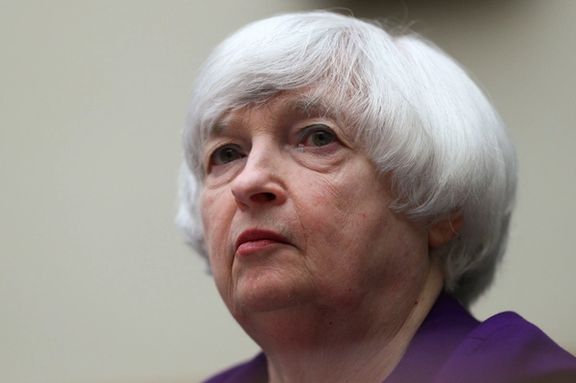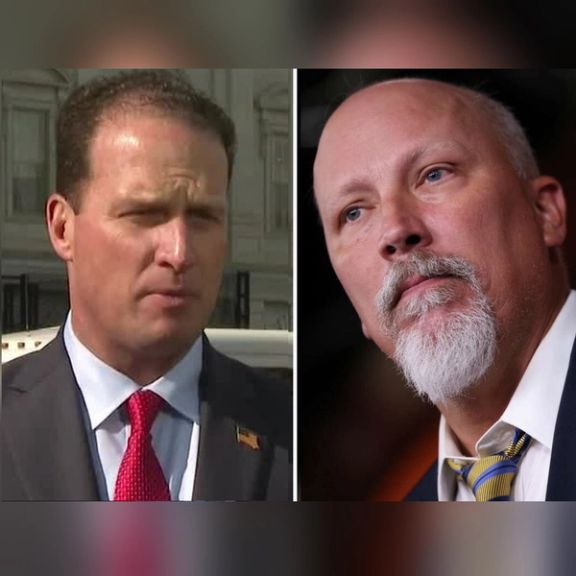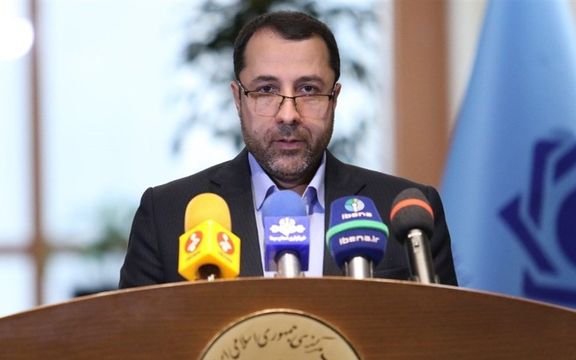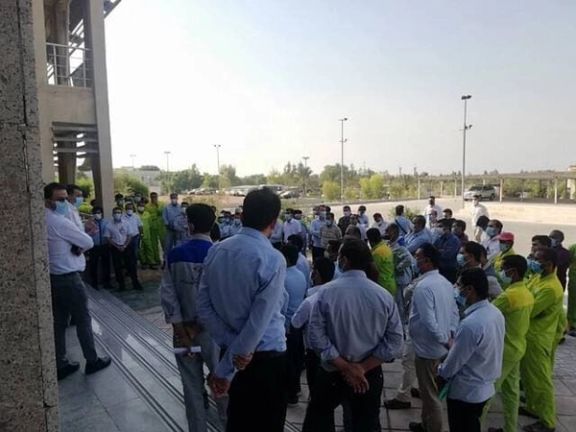Top US General Says IRGC Quds Force Is A Terrorist Organization

The top US general says he does not support removing Iran's Quds (Qods) Force, an arm of its Revolutionary Guards (IRGC), from a US terrorism list.

The top US general says he does not support removing Iran's Quds (Qods) Force, an arm of its Revolutionary Guards (IRGC), from a US terrorism list.
Chairman of the Joint Chiefs of Staff General Mark Milley told the Senate Armed Services Committee on Thursday, "In my personal opinion I believe the IRGC Quds Force to be a terrorist organization and I do not support them being delisted from the Foreign Terrorist Organizations (FTO) list."
Milley’s remarks were worded very carefully as he differentiated the IRGC from the Quds Force -- its extraterritorial military wing – suggesting that the Biden administration may considering delisting the IRGC as an FTO but keeping its Quds Force as a terrorist organization.
Such a move may be intended to resolve one of the remaining issues in talks to restore the 2015 nuclear deal known as the JCPOA that have reached a deadlock over Iran’s demand to delist the IRGC.
The Trump administration added the IRGC to the list in 2019. Iran insists that delisting the IRGC is a requirement and 'red line' for a deal, and its foreign ministry blames Washington for the delay in reaching a deal, saying the halt in the Vienna talks is due to US failure to make a "political decision".
The Biden administration has apparently not made a decision yet, amid rising opposition by Republican congressmen as well as a growing

The US Treasury says Washington will not allow Iran to access in dollars its reserve assets maintained by the International Monetary Fund (IMF).
Treasury Secretary Janet Yellen said Wednesday that Iran would not be able to receive in US dollars its special drawing rights (SDRs), a supplementary asset allocated by the IMF as a potential claim on the “freely usable currencies of member states.” The system is used by the fund to assist member states in the interests of the global economy, with the largest ever allocation approved in August 2021 to help countries cope with the Covid-19 pandemic.
Iran has been short of foreign reserves, especially dollars, since the US in 2018 imposed ‘maximum pressure’ sanctions threatening third parties buying Iranian oil or dealing with Tehran’s financial sector. Talks in Vienna between Iran and world powers have been taking place for a year to revive the 2015 Iran nuclear deal, which eased sanction in return for curbs on Iran’s atomic program.
Yellen’s remarks came in response to Louisiana senator John Neely Kennedy − an opponent of the 2015 Iran nuclear deal − who said Wednesday he wanted to know why the US administration was ‘supporting’ the IMF in allocating SDRs to Russia, Iran, and China.
The senator told the Washington Examiner that not enough attention was paid to what he claimed was the US backing the allocation of $650 billion in SDRs in 2021. Kennedy appeared to be referring to the total amount of SDRs allocated last year – by the IMF, not the US administration − expressed as a dollar equivalent.
‘Gift to Iran’
The Washington Examiner claimed Iran had in 2021 received $4.5 billion in SDRs, Russia $17 billion, and China $40 billion. “We ought to hold hearings and ask why” the US had approved this, Kennedy said. “There is some reason they wanted to do this, this is a gift to Iran, it’s a gift to China.”
Abdolnaser Hemmati, then governor of the Central Bank of Iran, said April 19, 2020, that Iran had asked to receive its SDRs as allocated by the IMF, which he valued at 3.6 billion in terms of US dollars.
SDRs are set in terms of a basket based on the US dollar, the Chinese renminbi, the euro, the Japanese yen and the British pound. A recent IMF paper highlighted the long-term decline of the dollar in international reserves, losing ground both to the Chinese renminbi and smaller currencies, and there has been growing criticism of the US ‘politicizing’ the dollar as an international currency. Despite US and western European sanctions, Russian international reserves increased $2.1 billion over the week ending April 1, reaching the equivalent of $606.5 bn, according to the Bank of Russia. Europe continued to buy oil and gas from Russia, but most of the reserves are frozen by Western sanctions.

Iran increased oil revenues 40 percent in past 12 months and injected 10 percent above the budget forecast into government coffers, the oil minister has said.
In a two-part interview published by official government new website, IRNA, on Tuesday and Wednesday (April 5, 6), Javad Owji presented a rosy picture of oil ministry accomplishments since he was appointed minister last August.
Although refusing to say who were Iran’s oil customers or details about export volumes and destination, Owji said that in the Iranian year 1400 that ended March 20, forty percent more crude and other hydrocarbon fuels were exported than in the previous year.
Roughly six months of this period fell into the presidential term of Hassan Rouhani and his oil minister Bijan Zanganeh, and six months was managed by Owji under Ebrahim Raisi’s presidency.
It is not fully clear from the interview how much of the additional exports were managed by the previous administration and what was the impact of “the jihadi management” Owji attributed to the new administration. But independent news reports have indicated a boost in recent months.
Based on multiple reports by industry sources and foreign news agencies throughout 2021, it was clear that Iran’s oil exports had substantially increased from a low of 200,000 barrels per day in 2019 to around 750,000 barrels in early 2021.
Owji explained that the government budget for the year 1400 assumed a revenue of $17,355 billion from all hydrocarbon exports. Based on law, the oil ministry receives 14.5 percent of this amount to reinvest in the sector while 20 percent is saved in the National Development Fund. The remaining 65.5 percent goes into the government’s operating budget. Owji said that because of higher exports, instead of $11,368 billion going to the government, it received 10 percent more.
Owji then stated that the government received 10 percent more from hydrocarbon exports than forecast in the budget. The budget was based on export of one million barrels of crude a day. The question here is that if 40 percent more was exported, why the government’s actual share increased only by 10 percent.
The explanation might lie in the one million barrel per day export volume set in the budget in early 2021, when Iran was probably exporting less, around 700,000 barrels. This volume might have increased later to above one million, with the government eventually receiving 10 percent more for the full year, and not 40 percent.
Owji’s remarks do seem to show that Iran’s illicit oil exports might have received a further boost in the closing months of 2021 and early 2022. China being the main destination, there were reports in the fall that Beijing was building up reserves, especially in December, by around 900,000 bpd, after months of small additions.
Expectations were that China would slow down the stockpiling of oil in early 2022, but by the end of February as prices soared, Beijing reportedly ignored United States calls for a coordinated oil release and instead kept building up its reserves.
To put Owji’s numbers in context, without US sanctions and full-capacity exports, Iran’s total annual oil revenue should top $60 billion, while it was under $20 billion in the past 12 months. With oil at above $100 a barrel since the Russian invasion of Ukraine, which was not the case in the past 12 months, revenues are certainly higher now, but would hardly reach even half of what it could be if sanctions were lifted.
Given the lost revenues since 2018 when sanctions began, the additional oil income since early 2021 helps Iran but is insufficient to make bring about a major improvement in its finances when the government owes tens of billions of dollars to domestic banks and creditors.

The Biden administration and the Democrats are doing everything to prop up Iran “in ways that undermine national security of US and Israel,” Republican congressman Chip Roy said Monday.
The Texas representative told Iran International’s correspondent in Washington that removing Iran’s Revolutionary Guards (IRGC) from the list of ‘Foreign Terrorist Organizations’ (FTO) would be “a foolish, wrong-headed and complete asinine policy.” August Pfluger, another Texas representative, told Iran International “it’s very important that we stand strong against the largest state sponsor of terrorism.”
The IRGC was added in 2019 by President Donald Trump to the ‘FTO’ list, the only example of a country’s armed forces being included. Pfluger argued that the IRGC should not be removed without Congressional approval, although it was added by Trump on presidential authority.
“We need to have a say,” Pfluger told our correspondent Arash Alaei in Washington. “We need to have our voices heard. So that the administration doesn't do something that's not listening to Congress, which is what we've been pushing for.”
The question of removing the IRGC as a ‘FTO’ is reportedly at issue in Vienna talks to revive the 2015 Iran nuclear deal, the JCPOA (Joint Comprehensive Plan of Action). Iran Monday said Washington’s failure to take political decisions in facing down domestic JCPOA opponents, including Republicans raising legislative hurdles like requiring Congressional support for IRGC delisting, had led to a delay in agreeing JCPOA arrival.

The chairman of Central Bank of Iran (CBI) announced Monday that in the past one year it provided 57 percent more foreign currency to people and businesses.
Ali Salehabadi, appointed by President Ebrahim Raisi last year to head the CBI, said on Monday that from March 21, 2021, until March 20, 2022 (the Iranian year 1400) the government dispensed $57 billion to individuals and businesses, a 57-percent rise compared with the previous 12 months.
The foreign currency market is largely controlled by the government, except a black market, where people can buy and sell hard currencies. The size of this unofficial market is hard to estimate, since transactions are off the books and deliberately hidden.
In Iran’s centralized economy and banking system the government has been controlling the large transactions, through evolving regulations in the past 43 years since the Islamic Republic was established.
Businesses can always buy dollars in the black market or through official channels after receiving the necessary approvals, but the government has to inject the hard currency, either through its official banking system or the black market, to finance imports and prevent a run on the national currency.
If the figure Salehabadi announced is true, it means the Islamic Republic had at least $20 billion more at its disposal in the past 12 months for making available $57 billion for imports and other needs, such as foreign travel and stipends for students abroad – not mentioning capital flight from the country.

Part of the available hard currency invariably leaves Iran in the form of individuals taking their money into safer markets, such as Turkey, the United Arab Emirates or Western countries.
Again, if Salehabadi’s claim is true, it means Iran earned $20 billion more during March 2021-March 2022, presumably from higher oil exports, banned by United States’ sanctions that are increasingly circumvented by Tehran.
There have been numerous reports since late 2020 that Iran has been selling more oil, clandestinely, mainly to China at cheaper prices. Iranian shipments have increased from as low as 200,000 barrels per day in 2019 to as high as more than one million barrels in late 2021.
The question is why the US has not tried harder to enforce its sanctions.
President Joe Biden decided to rejoin the 2015 Iran nuclear agreement that his predecessor abandoned in May 2018, which meant he would lift sanctions if an agreement could be worked out with Iran to mutually revive the deal known as the JCPOA. One of his first foreign policy actions was the start of multilateral talks in Vienna a year ago, and it appears that the administration decided not to go out of its way to enforce the economic sanctions.
China and others might have also calculated that Washington would not make a fuss about sanctions violations amid nuclear talks, which also involved Moscow and Beijing.
The result has been considerably higher oil income for Iran, that some argue has made Tehran confident enough not to have agreed to a deal in Vienna after 12 months of talks, and lately demanding more concessions from the United States.
Although more dollars flowed into Tehran’s coffers in recent months, the Iranian currency has remained weak, having lost its value eightfold since the beginning of 2018. One US dollar now buys 270,000 rials, compared with 34,000 in 2017, before the US imposed sanctions.
The reason for a lack of improvement for the rial, or in the case of a 40-percent annual inflation rate, could be the depth of the economic crisis gripping the country. A mere $20 billion cannot quickly make a dent in the inefficient economy, burdened by tens of billions of dollars of energy subsidies energy and military, ideological overhead.
Despite the additional income, Iran is by no means out of the woods. Any tightening of sanctions can erode the gain in oil exports and return the situation to the pressures of 2019.

President Ebrahim Raisi and his oil minister this week repeated claims that Iran has increased oil output and exports amid continuing United States sanctions.
President Ebrahim Raisi in a speech on Thursday declared that oil exports have reached the pre- 2018 levels, when former US president Donald Trump withdrew from the nuclear deal with Iran and began imposing sanctions on Iranian oil exports.
If Raisi meant that Iran is shipping two million barrels a day like it did in 2017, it would mean observers of the global oil trade have underestimated Iran’s illicit exports by almost 100 percent. Various estimates in recent months have ranged between 750,000 to one million barrels a day.
Raisi who is under a lot of pressure to improve the battered economy is using media under his government’s control and every public speech to claim economic successes.
The policy of claiming economic successes could also be a tactic to persuade the United States that its sanctions are ineffective and Iran can afford not to sign a nuclear agreement negotiated in Vienna if Washington rejects its demands.
Petroleum Minister Javad Owji also told Shana news agency on the same day that “the capacity of oil production has returned to pre-sanction period” reaching to more than 3.8 million barrels per day.

The key word in Owji’s remark is ‘capacity’ which could substantially differ from actual production. This claim was made earlier by other oil ministry officials. He did not give an exact figure about exports and it is not clear if president Raisi mixed up ‘production’ with ‘exports’ when he said Iran has reached the pr-sanctions level.
Domestic critics of the government have pointed out that the president’s claims of more oil revenues and economic growth are simply due to higher oil prices in recent months, and not any breakthrough in Iran’s economic fundamentals.
Average oil price in the first 7 months of 2021 was around $60 per barrel, while in the following 6 months (August-February) it was about $80. Raisi assumed office in the beginning of August. Following Russia’s invasion of Ukraine on February 24, prices shoot up well above $100.
During Donald Trump’s presidency, Iran’s clandestine oil shipments hovered around 200-300 thousand barrels pd but they picked up right before the US presidential election in November 2020 and steadily increased in 2021.
President Joe Biden’s administration apparently decided not to strongly enforce the sanctions, violated mainly by China, which has been buying the bulk of Iranian shipments.
The director of National Iranian Oil Company, Mohsen Khojasteh when asked a question by local media on Friday if exports increased because of lax enforcement by the United States, insisted that Iran was able to increase production capacity and exports despite sanctions.
Khojastreh claimed that the oil ministry made a $700 million investment since Raisi assumed office and revived production at 750 oil wells. He added that export of oil and other hydrocarbon products increased because Iran was able to find new customers but did not provide any details. Tehran regards such information as strategic secrets.
More exports and higher prices, however, have done little to visibly improve Iran’s economic indicators. Inflation continues to hover around 40 percent, with prices for food and other essential goods increasing to unprecedented levels. The government struggles to pay salaries and pensions, with no major proven investments in infrastructure, beyond general declarations of accomplishments.